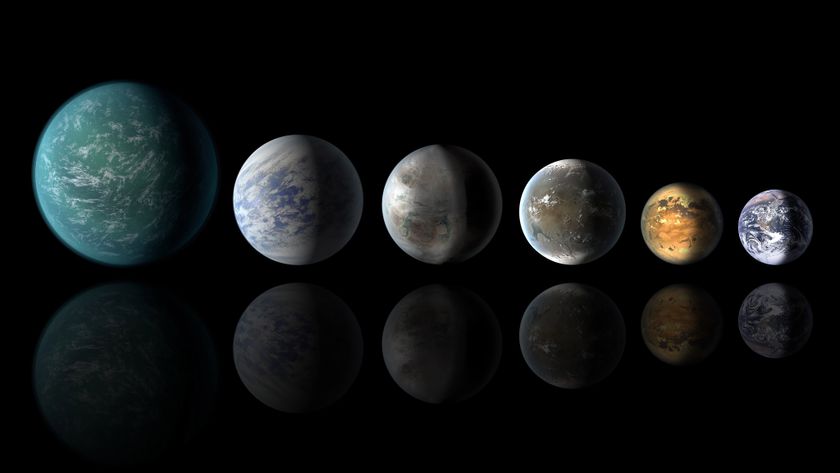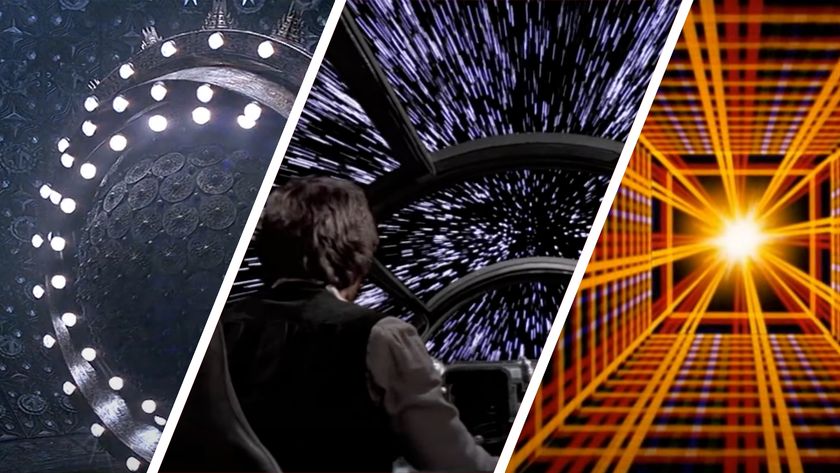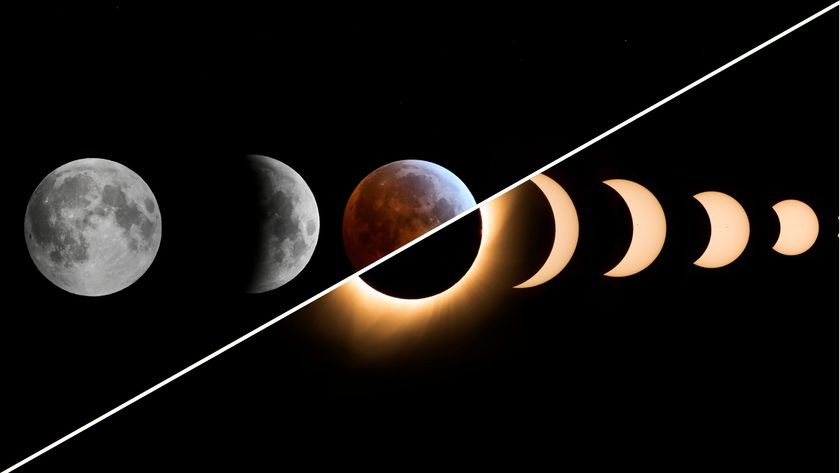Dark stars: The first stars in the universe
These cosmic creators, powered by dark matter, could be responsible for our existence, along with the appearance of today's universe.
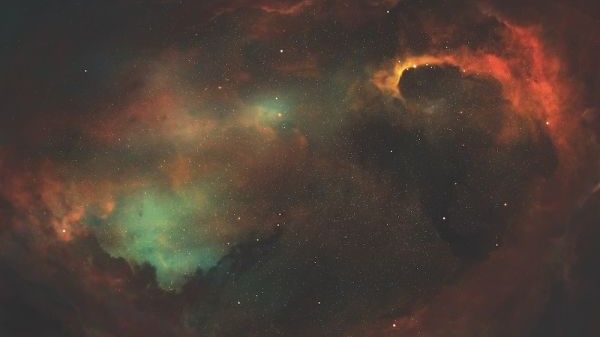
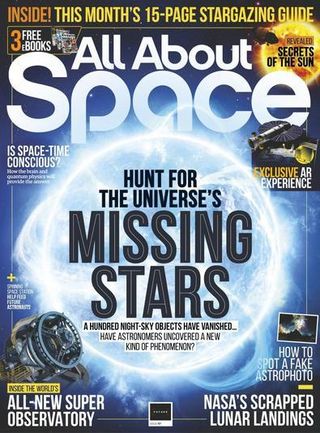
This article is brought to you by All About Space.
All About Space magazine takes you on an awe-inspiring journey through our solar system and beyond, from the amazing technology and spacecraft that enables humanity to venture into orbit, to the complexities of space science.
A star dies. A sudden flash of light signifies the end in a supernova explosion. This, however, is only part of the life cycle of stars, as the rich materials created during the death throes of the star are ejected into space by the supernova.
When the next generation of stars form, they sweep up the leftovers of the supernova, accreting the metals that the dying star produced — metals being the term that astronomers use for anything heavier than hydrogen and helium. Metals are important; without them, the disc of gas and dust surrounding a newly forming star could not create rocky planets. But if new stars recycle the metals produced in the deaths of old stars, what did the very first stars do?
The universe began with the Big Bang, which created the gases hydrogen and helium, trace amounts of lithium and perhaps beryllium as well. Matter began to clump together, pulling in ever more material through gravitational attraction. It may have been dark matter — the mysterious substance that has yet to be directly detected — that began to accumulate first. This then drew in the ordinary matter, the stuff we can see, such as hydrogen and helium. Together the dark and ordinary matter created what is known as a 'minihalo', although the name is somewhat misleading, as minihalos had masses around a million times that of our sun.
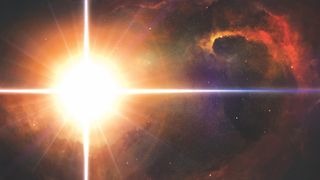
It was in the mini halos that the first stars were born 200 million years after the Big Bang.
The first stars are known as Population III stars, and none have ever been observed, as they are too faint. The first stars had to make do with what they had available, and formed from clouds containing only hydrogen and helium. When they died in supernovae explosions, they produced the first metals for the subsequent population of stars, Population II, which have a small proportion of metals. These went on to birth the metal-rich Population I stars we have today.
The dark matter in the minihalo may have done more than bring elements together — it might also have been present deep within the first stars. These stars are known as 'dark stars', due to the dark matter within them, although they would have actually shone very brightly.
Everything that we can see and detect — the stars and galaxies — only makes up a puny 5% of the universe, whereas dark matter comprises 25%. The rest is made of dark energy, another oddity thought to be responsible for accelerating the expansion of the universe. As CERN notes, dark matter does not interact with ordinary matter, and it does not produce any light. We only know that it must be there as its immense gravitational force tugs on ordinary matter.
One of the leading theories attempting to explain the invisible mass in the universe is a hypothetical particle known as a WIMP — a weakly interacting massive particle. 'Weakly' interacting refers to their relationship with ordinary matter. However, they would still interact with themselves. In fact, if two WIMPs collided with each other they would destroy each other in a process known as annihilation. This is because theories, such as this study at the University of Maryland, predict that WIMPs are their own 'antiparticles'.
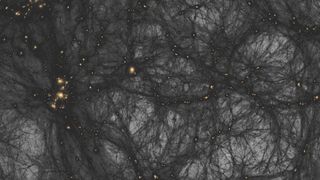
Ordinary matter has antiparticles, which are particles that have the same properties but are of opposite charge. Atoms consist of a nucleus surrounded by electrons. Electrons have a negative charge, and if they meet a particle known as a positron — with a positive charge — the electron and the positron will catastrophically annihilate each other.
A side effect of annihilation is that it produces energy. As a star begins to form in a minihalo, the collapsing material will contain hydrogen, helium, and WIMPs. At first the energy produced by the colliding WIMPs leaks out into space, but when the density of hydrogen is high enough, it traps the energy from the WIMPs inside the star. Even though the WIMPs only account for a tiny fraction of the mass of the star, they are so efficient at energy production that they can power a dark star for millions, or even billions of years.
It is still uncertain if all of the first stars were ordinary Population III stars with no dark matter, dark stars, or if both types of stars coexisted. "The standard scenario for the formation of the first stars does not rely on dark matter annihilation," says Erik Zackrisson from Uppsala University in Sweden. "Dark stars are simply seen as an exotic alternative to the standard formation route."
Ordinary stars are powered by fusion, the process that converts hydrogen into helium in the core of the star. The Population III stars would have been massive, weighing in at around 100 times the mass of our sun. However, they were also very hot, and this limited the amount of material that they could accrete. Dark stars, on the other hand, were much cooler. This meant that they could accrete substantially more of the surrounding material, and could theoretically keep growing as long as there was enough dark matter to fuel them, as NASA notes. Dark stars could have reached masses up to a million times that of the sun, with a luminosity a billion times brighter than it.

As the saying goes, all good things must come to an end, and the WIMPs will have eventually annihilated each other. Unlike Population III stars, which end their lives as supernovae, dark stars are so massive that they are fated to become a black hole. The smaller dark stars could take a detour on the way to oblivion by briefly igniting as an ordinary fusion-powered star. When this happened, the star would contract and become hotter. The hydrogen would have quickly been consumed in the belly of the star, and when the fusion engine could no longer support the star, the inevitable collapse into a black hole would have occurred.
The most massive of the dark stars would have bypassed the fusion stage altogether, collapsing straight into a black hole. These black holes were so massive that they offer a solution to a problem that had previously puzzled scientists. Supermassive black holes, which can be billions of solar masses, exist at the center of every galaxy, and are known to have existed only a billion years after the Big Bang. However, an ordinary star collapsing into a black hole would need more than a few hundred million years to gobble up enough material to become a supermassive black hole. "Ordinary stars cannot do it, because ordinary stars are too small," explains Katherine Freese from the University of Texas at Austin. "Dark stars, on the other hand, can grow to become a million times as massive as the sun, and then when they run out of fuel they collapse into million-solar-mass black holes, the perfect seeds for monstrous supermassive black holes."
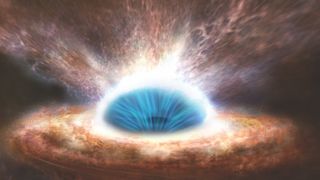
The supermassive WIMP-powered dark stars could only have formed in the minihalos of the early universe, when the density of dark matter was much higher than it is today. Over time, as the universe expanded, everything became more spread out, so there are no longer minihalos capable of birthing supermassive dark stars.
This confines them to the early universe, which also means that they are at a great distance from us here on Earth. Astronomers use the term 'redshift' to denote distance in cosmology, as the light from a distant object will get shifted towards the red end of the spectrum, permitted that it's moving away from us. Dark stars only exist at high redshifts, making them an observing challenge. The infrared Ultra Deep Field images taken by Hubble were used to look for dark stars, but none were found. This doesn't necessarily mean they don't exist, as there could be less luminous dark stars lurking beyond Hubble's vision. The upcoming James Webb Space Telescope (JWST) — due to be launched in October 2021 — will outdo its predecessor by looking further back in time.
"If dark stars do exist, and are sufficiently massive, numerous and long-lived, then the JWST certainly has a decent chance of confirming their existence at high redshifts," says Zackrisson. "However, since the distribution of dark star properties hinges on both the properties of the dark matter particles and the cosmological evolution of the dark matter halos that host them, success is by no means guaranteed."
Even if the JWST can't detect individual dark stars, it might still be able to detect their overall glow. Just as individual street lights all add up to produce an infuriating yellow glow over cities, light from stars and galaxies accumulates into what is known as the extragalactic background light (EBL). The EBL has already been mapped to a certain extent, but the improved measurements from the JWST will help to sniff out the contributions from dark stars, which hasn't been manageable before.
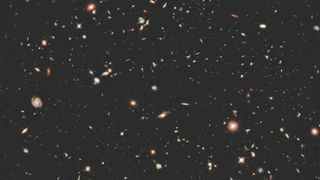
While WIMP annihilation can theoretically provide enough fuel to keep a dark star going for billions of years, it is unlikely that any of the dark stars from the early universe are still around today. However, it is possible that a new generation of dark stars could exist where dark matter concentrations are still somewhat high, such as in the centre of galaxies. As there is less dark matter in galactic centers compared to the minihalos of the ancient universe, the new generation of dark stars would be much less massive—only equivalent to that of our sun—and will never be able to rival the glory days of the first stars.
Solar-mass dark stars near the galactic center would not have formed while trapping WIMPs inside them, but rather by capturing some of the dark matter that resides at the center of the galaxy. When this happens, dark matter heating takes over from ordinary fusion, and the stars cool and expand. Not only would this make them appear younger than they actually are, but it could also extend their lifetimes exponentially. If there was enough dark matter for them to continuously accrete it, the dark stars could exist indefinitely. Everlasting dark stars could bookend the lives of some stars in the universe.
Another possibility is that 'dead' stars such as neutron stars or white dwarfs at the galactic center could gather enough WIMPs in order to trigger dark matter heating, as noted in a study at Queen's University in Kingston, Ontario. These stars would otherwise become fainter over time, but with a new heating source they would get a new lease of life, and appear strangely younger and hotter than expected.
Understanding the early years of our wondrous universe and how the first stars came to be is crucial to understanding what we see around us today, as well as understanding the more complex objects and phenomenons in the solar system. It is a murky period that is difficult to observe, but with the next generation of telescopes, such as the JWST, it might finally be possible to detect both the supermassive dark stars of the early universe and their less impressive cousins in the galactic center.
Discovering whether it was Population III stars, dark stars, or both that were the first stars to form in the universe will have a profound effect on cosmology. It won't be long before we can shed some light on these dark members of the cosmos.
Join our Space Forums to keep talking space on the latest missions, night sky and more! And if you have a news tip, correction or comment, let us know at: community@space.com.
Get the Space.com Newsletter
Breaking space news, the latest updates on rocket launches, skywatching events and more!
Amanda Doyle is a freelance science writer who studied astrophysics at Keele University in the United Kingdom, earning a Ph.D. for her studies into the spectral analysis of solar-like stars. Her work as appeared in All About Space Magazine, BBC Sky At Night and Astronomy Now. She is a former editor of Popular Astronomy and has served as Deputy Transport Editor at Chemical Watch news & events by Enhesa.


